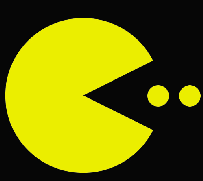|
This article appeared in the May 2011 edition of INNsight newsletter
Teva strikes again
Readers of a certain age will recall the dark ages of personal computing. This was a little after the first steam-driven mainframes had followed the dinosaurs into extinction but before everybody had on the desk or in their briefcase a tiny fragment of silicon that allows them to surf the net, check their mail, watch video, listen to music and even do some work.
In those days, a game that had made the transition from games arcades become very popular. Pacman was a cheerful yellow character that ran up and down the screen swallowing everything in its patch and becoming bigger and stronger as it went along, unl ess the player took a wrong turn and ended up being swallowed by a ghost. ess the player took a wrong turn and ended up being swallowed by a ghost.
You can see from my description why the Pacman character easily springs to mind (well, at least to my mind) when I read the news about yet another Teva acquisition.
In the last couple of weeks Teva has acquired Cephalon in the US for $6.8bn and 57% of Taiyo in Japan for $460m. These can be added to the long list of previous acquisition that the company has made to turn it into the leader of the generic pack by some distance. Not bad for a company based in a country that has about half the population of Greater London. It is an interesting thought that the world’s No.2, Sandoz, also comes from a country with a relatively small population. Perhaps there is a lesson to be learned there – that companies in small countries are forced to make the leap outwards into the other markets that will allow them to compete and grow whereas those based in larger markets can take things easy by selling locally. Then when the smaller and cheaper competitors arrive in their domestic market they suddenly find it difficult to compete.
Anyway, that is a digression. The point that I really wanted to make is that these latest acquisitions were clearly not made because somebody at Teva looked at the bank account, discovered that there was a bit of spare cash and decided to go shopping. There is a strategy that perhaps illustrates the way the generic industry is going.
What did Teva see in Cephalon? The answer is a combination of branded products and a good generic distribution network through Cephalon’s own recent generic acquisition Mepha that is itself active in over 50 countries. According to Bloomberg, when Cephalon's range is added in, Teva will have $7bn a year in branded sales including two blockbusters, Copaxone and Cephalon's Provigil.
And the attractions of Taiyo? It allows Teva to what the Financial Times describes as “a leap towards its ambition of becoming Japan’s largest generic drugs group” by taking control of the country’s third-largest generics player. The FT also points out that while Japan is the world’s second biggest pharmaceutical market after the US, its generic development lags a long way behind with a 23% market share compared to the 70% seen in the US. In the longer term, Teva’s ambition for its Japanese activities is a turnover of US$1 bn by 2015, which now becomes a lot more feasible when $200m of existing sales at its existing JV with Kowa are supplemented by Taiyo’s $530m turnover.
In Teva’s opinion, it seems, the future lies in reducing its dependence on the “pile it high, sell it cheap” school of commodity generics and moving up stream into higher value brands and also new markets where competitive pressures are lower than in the European and US generic markets. This makes sense because history has already shown that however cheaply Company A makes a product, Company B will eventually turn up with a cheaper version until Company C turns up and undercuts them both. Running faster and faster to stay on the same spot is not a viable long-term strategy.
On the positive side, there will always be a need, indeed a growing need, for generics in large volumes, but they cannot be a sustainable basis for a business by themselves unless supplemented by speciality generics, higher priced brands, OTC products and geographic expansion in the way that Teva is expanding its business.
If you have any questions or comments,
Please feel free to contact me
peter@interpharm-consultancy.co.uk
www.interpharm-consultancy.co.uk
o
|



